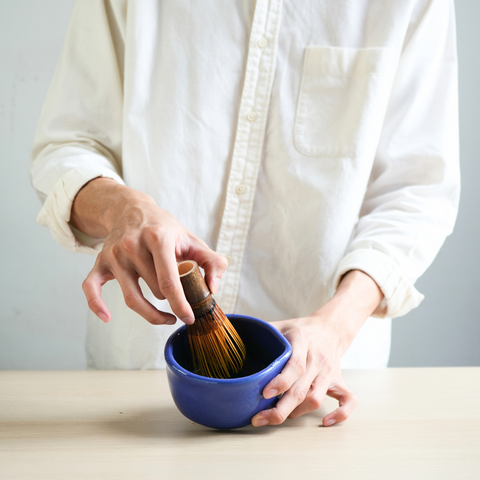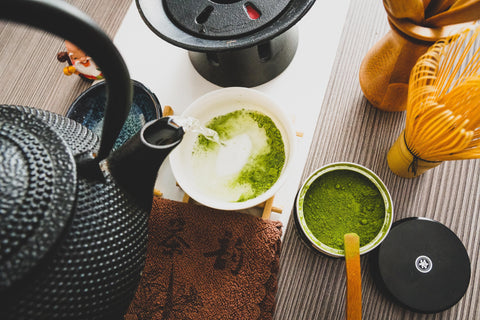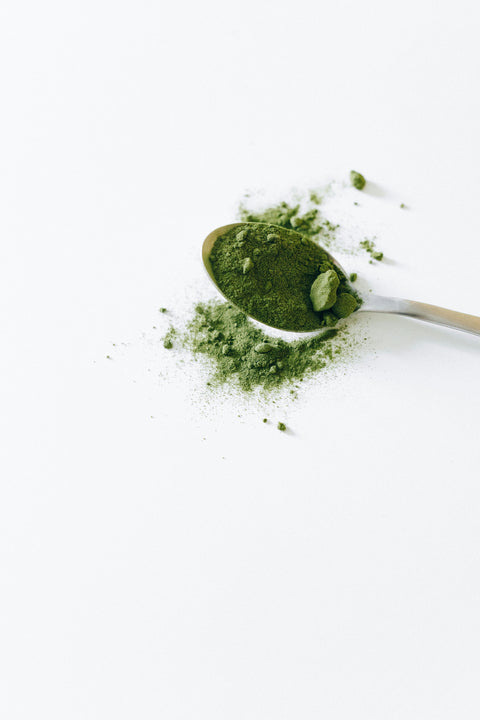
The Japanese tea ceremony — known as chanoyu, sado, or chado — is more than just preparing and drinking tea. It’s a cultural art form that blends hospitality, mindfulness, and aesthetics into a single, intentional experience.
At the heart of this tradition is matcha, the finely ground green tea that has been cherished in Japan for centuries. In this article, we’ll explore the history, philosophy, steps, and symbolic meaning behind the Japanese tea ceremony — and how this tradition continues to inspire modern matcha culture today.
1. The Origins of the Japanese Tea Ceremony
The practice of drinking powdered tea was introduced to Japan from China in the late 12th century by Buddhist monk Eisai, who brought tea seeds and the Zen concept of mindful tea preparation.
Over time, Japanese tea culture evolved into a unique art form, heavily influenced by Zen Buddhism, which emphasised simplicity, impermanence, and the beauty of the present moment.
The tea ceremony as we know it today was largely shaped by Sen no Rikyū (1522–1591), a tea master who refined the principles and aesthetics of the ritual into a practice of spiritual depth and humility.
2. The Philosophy of the Tea Ceremony
The Japanese tea ceremony is guided by four core principles established by Sen no Rikyū:
-
Wa (Harmony) — creating balance between host, guests, setting, and nature.
-
Kei (Respect) — honouring every person, object, and moment in the space.
-
Sei (Purity) — cleansing the body, utensils, and mind before and during the ritual.
-
Jaku (Tranquility) — achieving inner peace through the ceremony’s flow.
These principles are not limited to the tea room; they are meant to carry into everyday life.
3. The Setting: Chashitsu and Chakai
Tea ceremonies are often held in a chashitsu (tea room) or a tea house within a garden. Every detail — from the tatami mat layout to the seasonal flower arrangement (chabana) and hanging scroll (kakemono) — is chosen to reflect the season, occasion, and mood.
A chakai is a shorter, more casual tea gathering, while a chaji is a formal event that can last up to four hours and may include a multi-course meal (kaiseki) before the tea.
4. The Tools of the Tea Ceremony
The preparation of matcha involves specialised utensils, each with symbolic and practical significance:
-
Chawan — tea bowl, chosen to suit the season and occasion.
-
Chasen — bamboo whisk used to blend matcha into a frothy, smooth drink.
-
Chashaku — bamboo scoop for measuring matcha powder.
-
Natsume or Chaire — tea caddy for storing matcha.
-
Kensui — waste water bowl.
-
Fukusa — silk cloth for purifying utensils.
Each tool is handled with precise movements that reflect respect and care.
5. The Ritual: Step-by-Step
While the exact flow can vary depending on the school of tea (e.g., Urasenke, Omotesenke, Mushanokoji-senke), the general sequence is:
-
Greeting Guests — Guests purify themselves at a stone basin before entering.
-
Appreciating the Setting — Guests observe the scroll, flowers, and utensils.
-
Serving a Meal or Sweets — Wagashi (traditional Japanese sweets) are served to balance matcha’s bitterness.
-
Preparing the Tea — The host carefully measures, sifts, and whisks matcha.
-
Drinking the Tea — Guests rotate the chawan before sipping, showing respect to its design.
-
Concluding the Gathering — The host cleans the utensils, and guests express gratitude.
6. The Symbolism of Matcha in the Ceremony
Matcha in the tea ceremony symbolises more than a drink — it’s a medium for mindfulness. The act of whisking the powder into hot water represents the blending of body and mind in harmony with the present moment.
Every sip is an invitation to pause, connect, and appreciate.
7. The Tea Ceremony in Modern Life
While formal tea ceremonies are less common in everyday Japanese life, the spirit of chado lives on in modern matcha culture. Many cafés, tea houses, and cultural centres in Japan and around the world still conduct ceremonies for education and appreciation.
For matcha lovers outside Japan, embracing even small aspects of the ceremony — such as using a chasen, slowing down to prepare tea, or enjoying it in silence — can bring the same grounding benefits.
Final Thoughts
The Japanese tea ceremony is a timeless blend of art, culture, and mindfulness. Its focus on harmony, respect, purity, and tranquility offers lessons that extend far beyond the tea room.
At Forest Cloud, our ceremonial-grade matcha is sourced from Japanese farms that honour these traditions — ensuring every cup you make at home carries a touch of the same spirit.
Whether you wish to master the full ceremony or simply slow down with a mindful cup, matcha is a bridge between centuries-old tradition and modern life.
Explore Forest Cloud Ceremonial Matcha →






